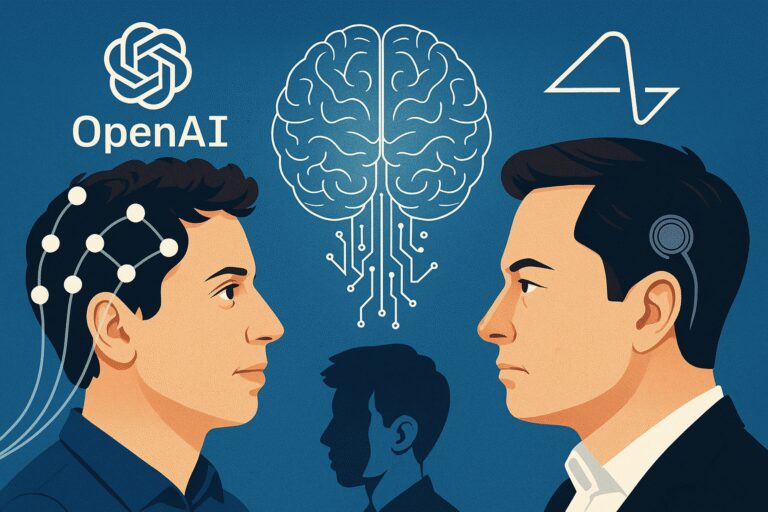The brain-computer interface race is heating up as artificial intelligence giant OpenAI reportedly sets its sights on neural technology, potentially creating a formidable challenge to Elon Musk’s established Neuralink operation. This emerging competition could reshape how we think about direct connections between human minds and digital systems, with implications that extend far beyond the tech industry.
The New Player in Neural Territory
While OpenAI has built its reputation on large language models and artificial intelligence systems like ChatGPT, industry insiders suggest the company is exploring opportunities in brain-computer interfaces (BCIs). This potential expansion would mark a significant strategic shift, positioning OpenAI as a direct competitor to Neuralink in one of technology’s most ambitious frontiers.
Brain-computer interfaces represent the cutting edge of human-machine interaction – devices that can read neural signals and translate them into digital commands, or vice versa. Think of typing with your thoughts, controlling robotic limbs through mental intention, or even downloading information directly to your brain.
Neuralink’s Head Start
Elon Musk’s Neuralink has dominated headlines in the BCI space since its founding in 2016. The company has achieved several notable milestones:
| Year | Neuralink Achievement | Significance |
|---|---|---|
| 2020 | Pig brain implant demonstration | First public proof of wireless neural recording |
| 2021 | Monkey plays Pong with brain signals | Demonstrated motor control applications |
| 2024 | First human patient trials | Early stage human testing begins |
Neuralink’s approach focuses on ultra-thin “threads” containing electrodes that can be surgically implanted into brain tissue. The company’s ambitious long-term vision includes treating neurological conditions, restoring lost sensory functions, and eventually enabling a symbiotic relationship between human intelligence and artificial intelligence.
OpenAI’s Potential Advantages
Should OpenAI enter the brain-computer interface arena, the company would bring several unique strengths to the competition:
AI Integration Expertise
OpenAI’s deep understanding of artificial intelligence systems could prove invaluable in developing BCIs that can intelligently interpret and respond to neural signals. The company’s experience with natural language processing might translate into more intuitive thought-to-text applications.
Established Infrastructure
Unlike many startups in the BCI space, OpenAI already possesses significant computational resources, funding, and talent acquisition capabilities. This infrastructure could accelerate development timelines and reduce the typical growing pains of emerging tech companies.
Different Approach Philosophy
While Neuralink emphasizes surgical implants, OpenAI might explore less invasive approaches, such as external sensors or minimally invasive devices that could appeal to broader consumer markets more quickly.
The Broader Implications
Competition between these tech giants could benefit consumers and patients in several ways:
Accelerated Innovation
Competition typically drives faster innovation cycles and technological breakthroughs. Multiple well-funded teams working on similar challenges often leads to rapid advancement in capabilities and performance.
Diverse Solutions
Different companies bring varying approaches to complex problems. While Neuralink focuses on high-bandwidth surgical implants, OpenAI might pursue complementary technologies that serve different use cases or patient populations.
Safety and Standards
Increased competition often results in more rigorous safety protocols and industry standards, as companies work to differentiate themselves through reliability and trustworthiness.
Challenges Ahead
Both companies face significant hurdles in the brain-computer interface space:
Regulatory Approval
The FDA approval process for neural implants is lengthy and complex, requiring extensive safety and efficacy testing. Any new entrant must navigate these same regulatory challenges that have slowed progress across the entire industry.
Technical Complexity
The human brain contains approximately 86 billion neurons with trillions of connections. Creating interfaces that can meaningfully interact with this biological complexity while maintaining safety represents one of engineering’s greatest challenges.
Ethical Considerations
Brain-computer interfaces raise profound questions about privacy, consent, and human enhancement. Companies in this space must address concerns about mental privacy, data security, and equitable access to potentially life-changing technologies.
Market Implications
The global brain-computer interface market, currently valued at several billion dollars, could experience explosive growth with major tech companies competing for market share. Analysts predict the BCI market could reach tens of billions of dollars within the next decade as applications expand from medical treatments to consumer electronics and human enhancement.
Medical Applications
The most immediate applications likely focus on treating neurological conditions such as paralysis, depression, and neurodegenerative diseases. Success in these areas could provide the foundation for broader consumer applications.
Consumer Markets
Future consumer applications might include enhanced gaming experiences, direct device control, or augmented cognitive capabilities. However, these applications will likely require significant advances in safety, reliability, and user experience.
The Road Ahead
While Neuralink maintains its first-mover advantage and established research programs, OpenAI’s potential entry into brain-computer interfaces could reshape the competitive landscape. The combination of OpenAI’s AI expertise and significant resources could accelerate progress in neural technology development.
For consumers and patients, this competition represents hope for faster development of life-changing technologies. Whether addressing medical conditions, enhancing human capabilities, or creating entirely new forms of human-computer interaction, the race between these tech giants could benefit society as a whole.
The brain-computer interface revolution is still in its early stages, but with major players like OpenAI potentially joining established companies like Neuralink, we may be approaching a pivotal moment in the relationship between human minds and digital technology. The next few years will likely determine which approaches prove most effective and which companies can successfully bridge the gap between ambitious visions and practical, safe applications.

